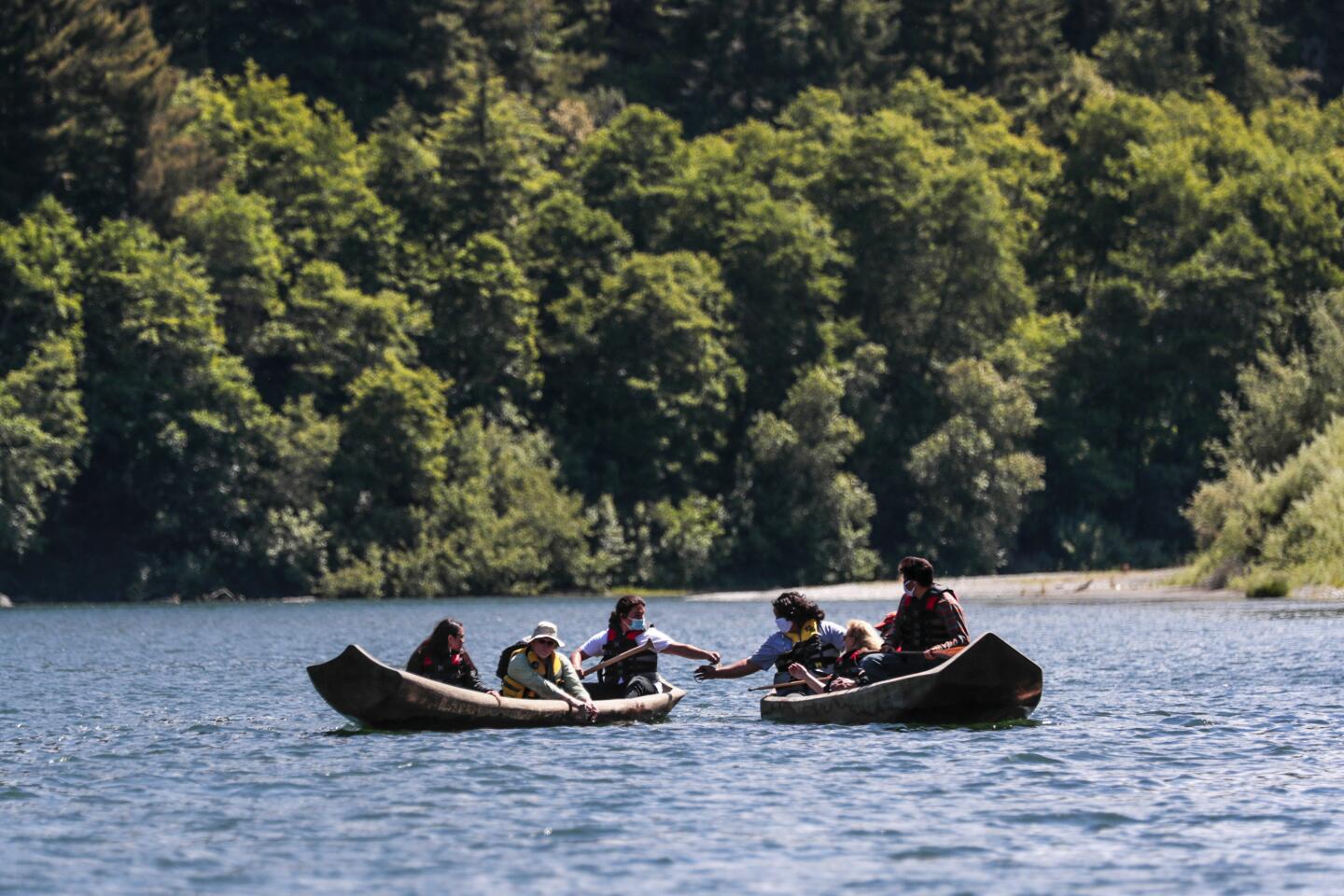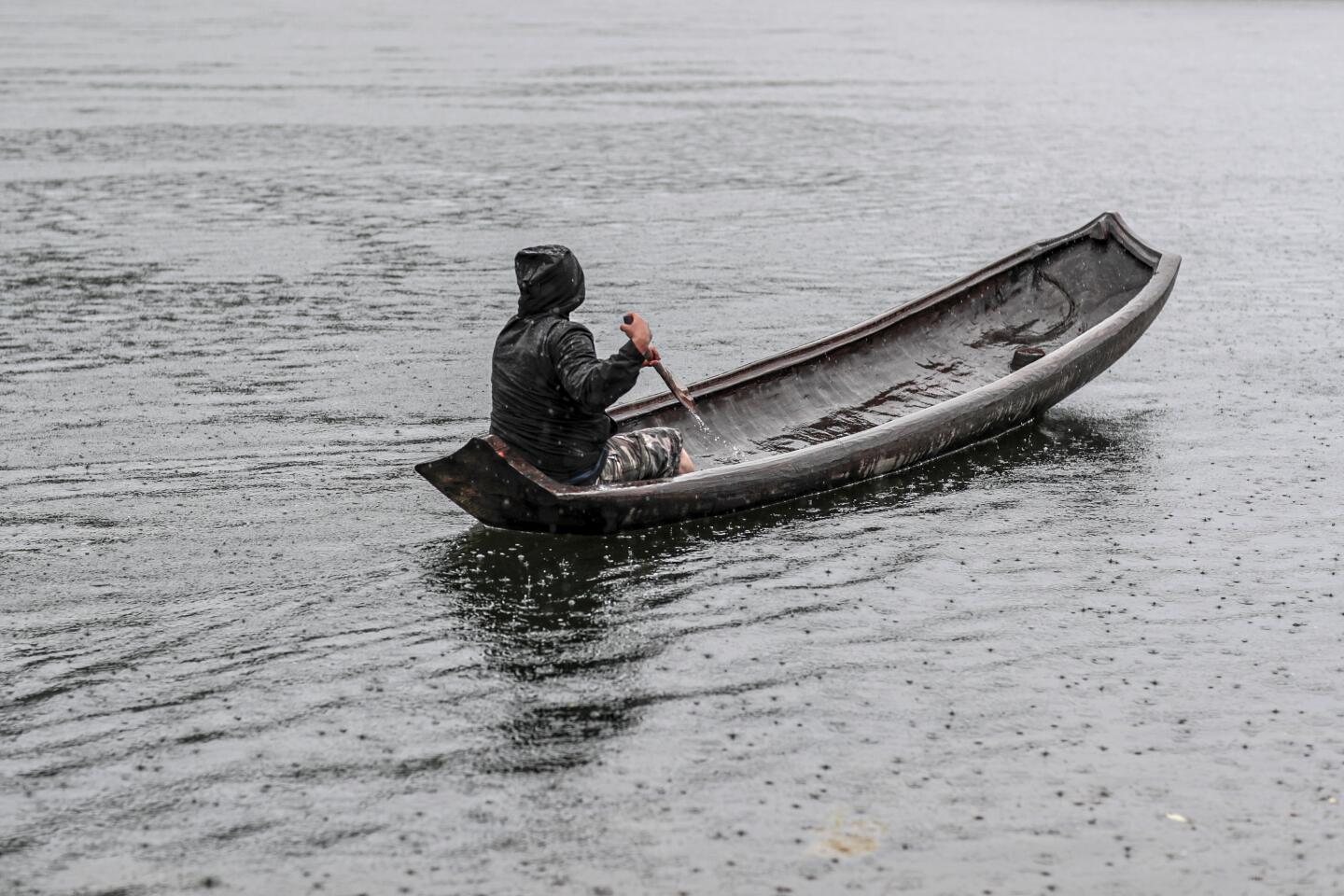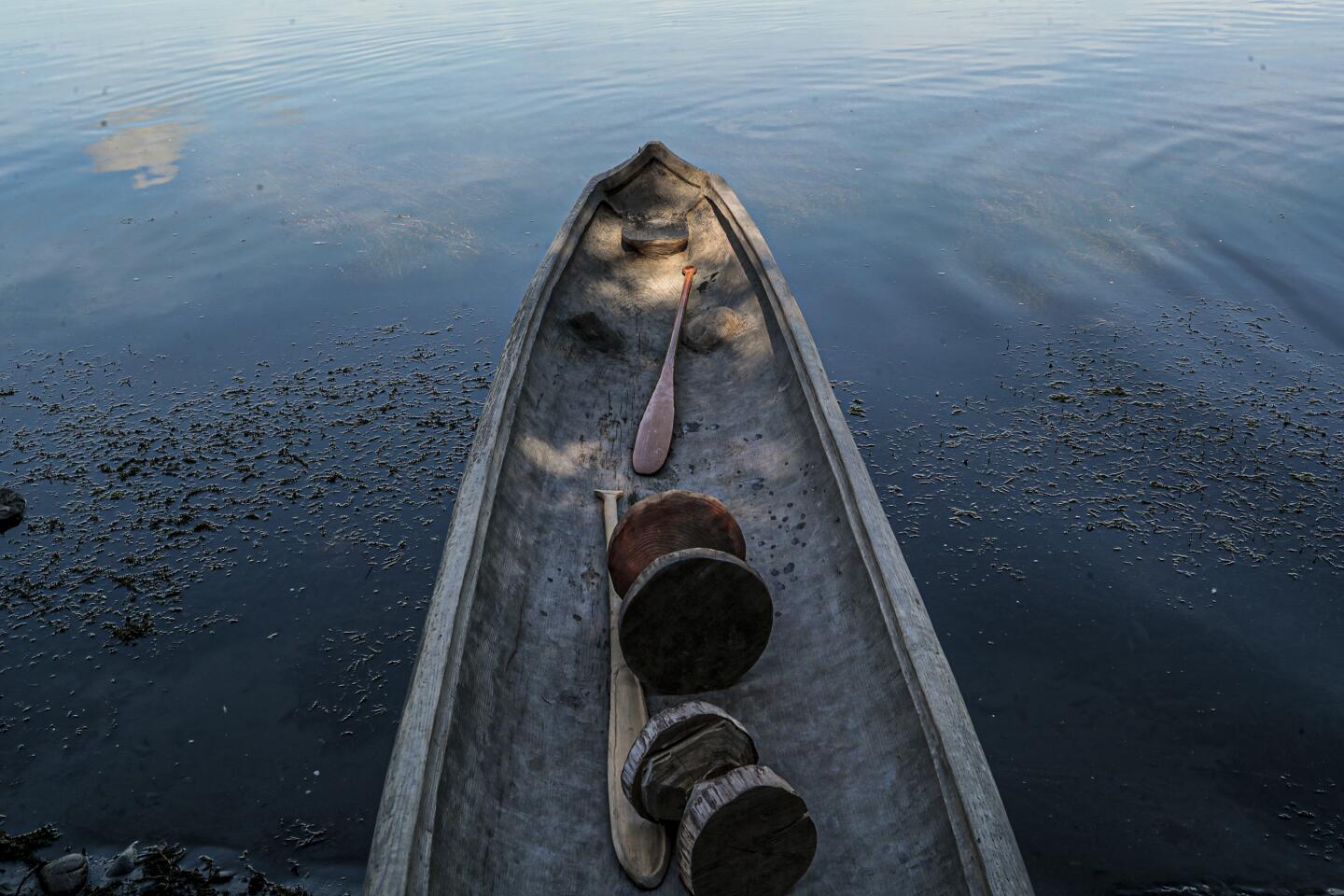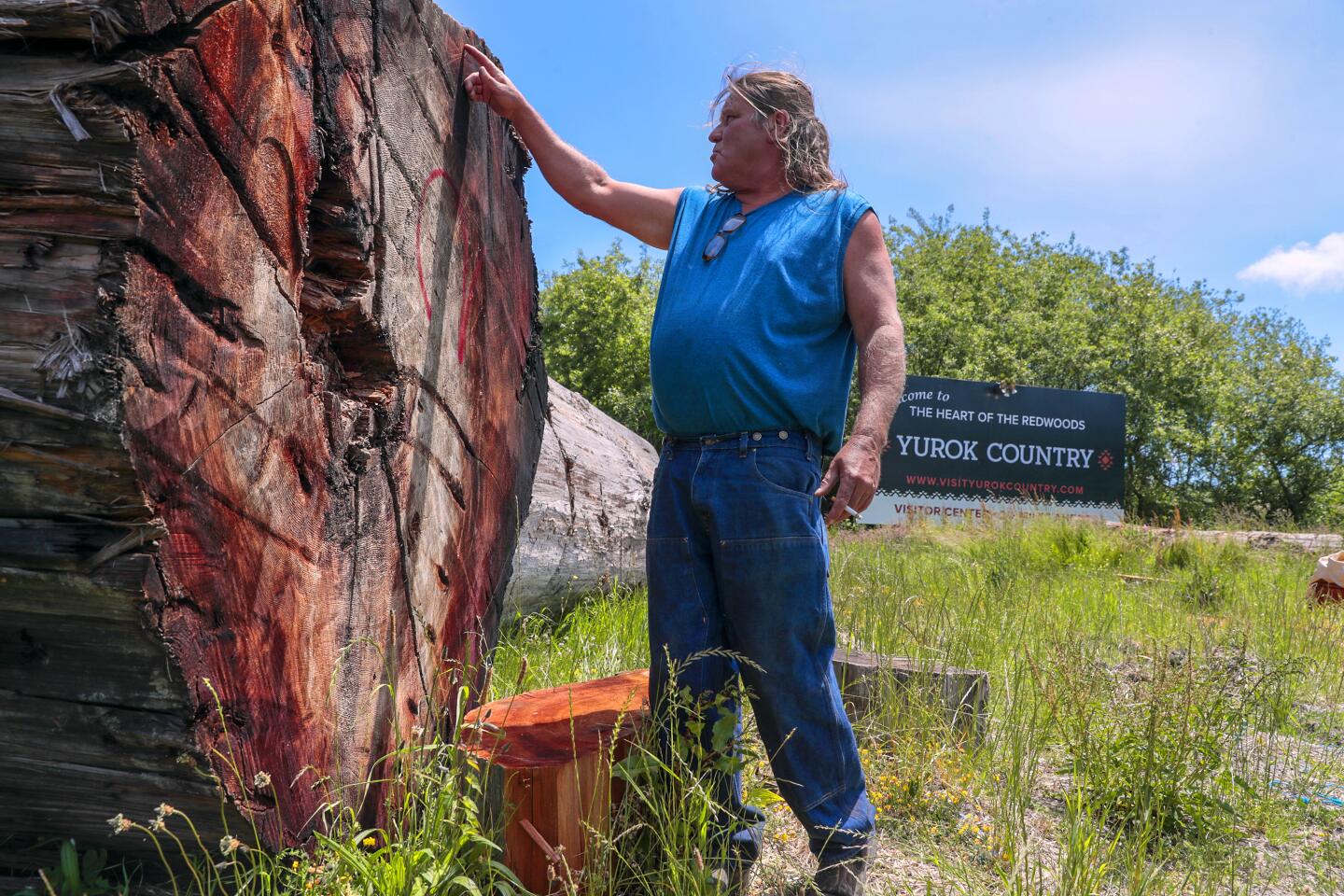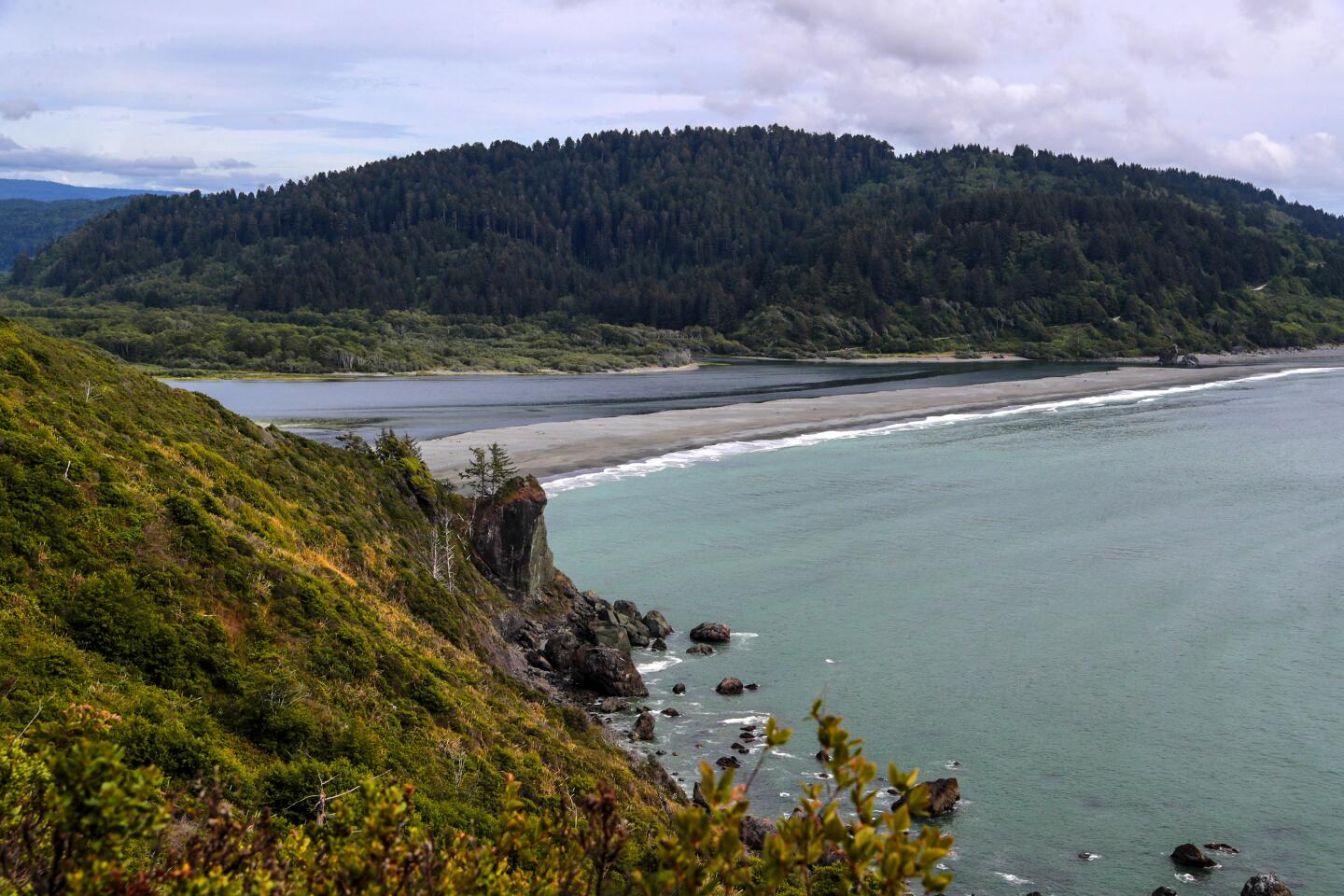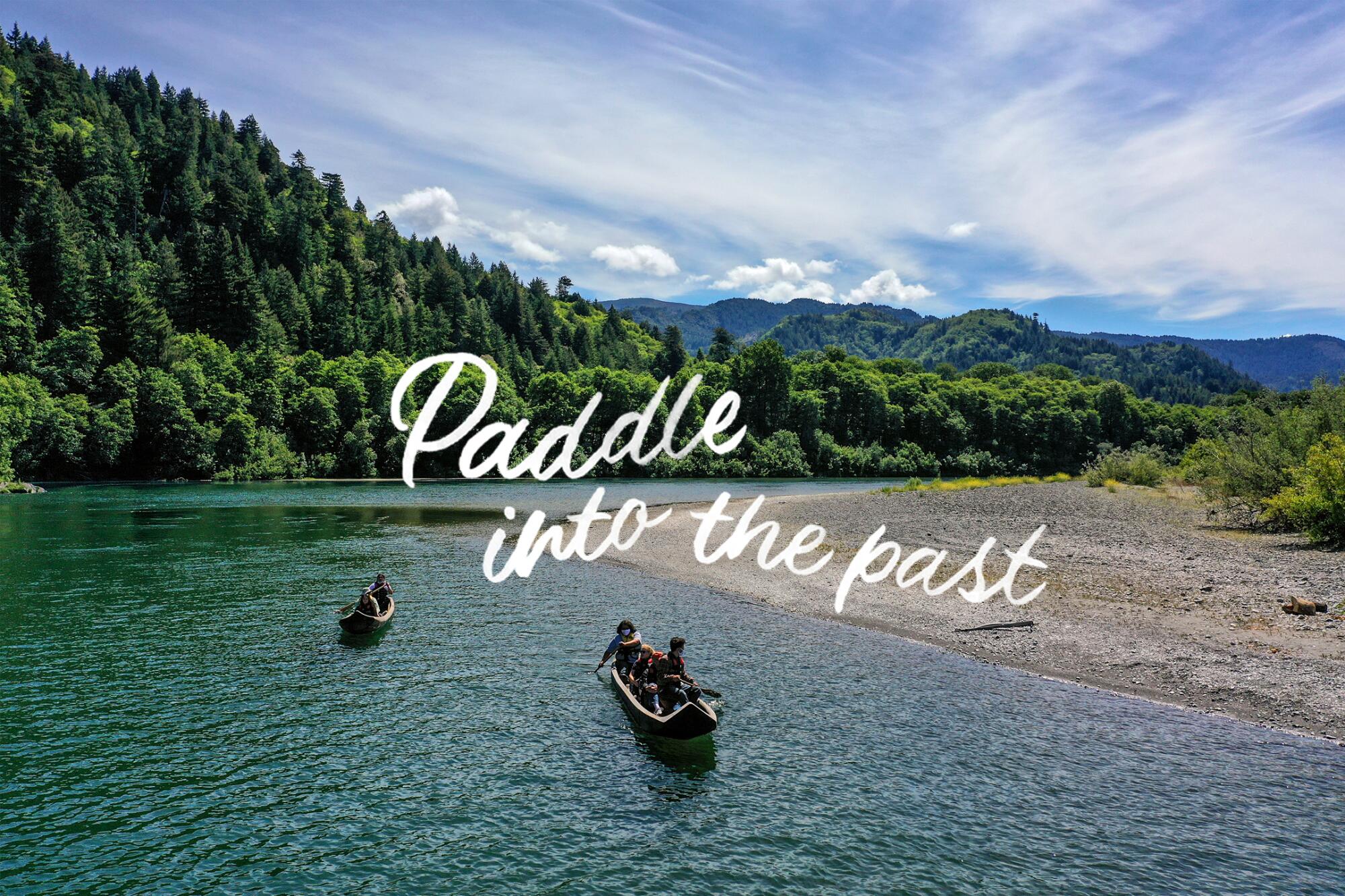
- Share via
KLAMATH, Calif. — We were about to nudge our dugout canoes into the Klamath River when Sammy Gensaw spoke up.
“These are the rarest vessels in the world,” said Gensaw, a guide for the Yurok tribe’s fledgling canoe tour business. “There are only about 10 in existence, and these two are the only ones open to the public.”
I ran one hand along the boat, a single solid piece of redwood carved according to millennia of tribal custom. Then we shoved off into the river.
We were in California’s Del Norte County, 40 miles south of the Oregon border and about five miles upstream from the spectacular estuary where the river meets the Pacific at a sand bar under jagged cliffs.
As we paddled upriver, then down, we kept an eye out for bees at Terwer Creek. Near Snake Rock, we looked in vain for the family of otters that sometimes shows up to say hello.
We spotted a crane in flight, then an egret and a kingfisher, and just a handful of other boaters. We drifted beneath the U.S. 101 bridge, which is guarded by two golden bear sculptures at each end.
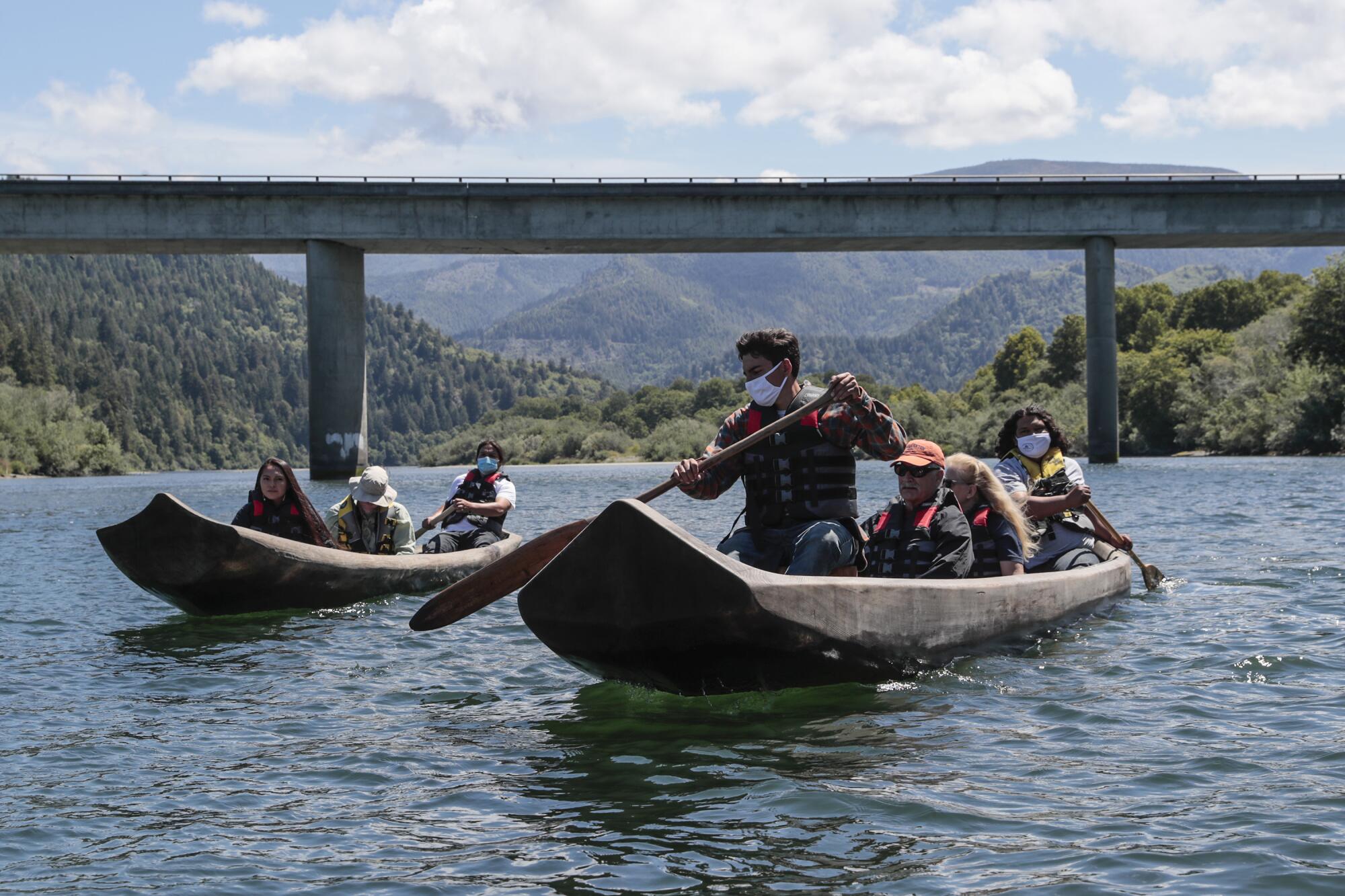
The lower Klamath River and the redwoods, which grow nowhere else on Earth, are at the heart of Yurok culture. The tribe’s reservation follows the river for its last 44 miles and extends one mile from each bank, just broad enough to accommodate dozens of tiny, remote villages and the modest town of Klamath along the 101. The west end of the reservation is surrounded by Redwood National and State Parks.
I wanted quality time on the water and under tall trees, but I also wanted to learn more about a people who were navigating this river thousands of years before the first Gold Rush prospectors reached California.
To reach the river, Times photographer Robert Gauthier and I had flown to Humboldt County’s airport just north of Eureka, rented a car and driven an hour north to Klamath, where we spent the night.
The next morning, we met our Yurok guides at the recently opened Yurok Country Visitor Center and headed to a boat ramp.
Gensaw and guide Zechariah Gabel took seats at either end of a vessel made in 1967 by master carver Dewey George. I rode in the second canoe, completed last year by wood carver David Severns, with Sammy’s brother, Jon Luke.
For now, that’s the fleet — two canoes. The first tours, delayed a year by the pandemic, were free in May for tribal members, followed by paying customers in early June (and by Gov. Gavin Newsom on June 30). The tours cost $125 per person for a two-hour trip, which can be booked online.
Subscribers get early access to this story
We’re offering L.A. Times subscribers first access to our best journalism. Thank you for your support.
I showed up after the tribal members and before the governor and paid an extra $25 for a paddling lesson with my tour.
To a newcomer in a canoe, like me, the lower Klamath River can seem a flawless natural wonder, with willows, alders, fir and cottonwood crowding its banks. Redwoods march up the slopes. Yes, there’s a drought on, but here you hear birdsong and smell the wet forest.
It was a startlingly smooth journey, the canoe more stable than any kayak or canoe I’d ever tried. Paddlers and passengers sit on redwood stools that you can move forward and back. (Everyone’s back is different, but this was easy on mine.)
Because we stayed away from rougher waters near the estuary and the wind was calm, we hit just one patch of white water, so mild that I’d hesitate to call it a rapid.

But the Klamath is capable of great and terrifying things, and proof of that is just downriver from the 101 bridge: the elevated stub of Douglas Memorial Bridge, which was destroyed in 1964 by floodwaters that also swept away the center of Klamath.
Seeing that broken bridge, and picturing all that surging water, is enough to keep a paddler humble. And wary.
In this place, paddling “is all about connecting with the water, the weather and the wind,” said Sammy Gensaw. “You’re not just driving a redwood canoe.”
But as just about any Yurok will tell you, this river is not well. It has too many dams upriver, too much algae and not enough salmon. The drought and a salmon-afflicting parasite haven’t helped either.
As our canoes nosed farther downstream, Gensaw eased us into the river’s story, recounting how newcomers in the 19th and 20th centuries grabbed land, transmitted diseases, started logging, opened fish canneries and built dams.
The Yurok population, the old-growth redwood forest, the river’s salmon fishery — all were reduced to fractions of what they had been.
The Yurok language, however, is recovering from near extinction, sustainability is on more people’s minds, and four dams are scheduled for removal by 2024. After years of struggle, the Yurok are hoping their river is on the brink of happier days. Their culture too.
“We’re pretty sure the river’s going to be healthier,” said Josh Norris, who manages the canoe tour operation.
Honor the redwood
So why, after such painful history, are the Yurok bringing strangers aboard their prized canoes?
“This tourist thing is perpetuating our culture,” said Severns later in our visit.
Severns is part of the tribe but not part of the tour. By making, paddling and teaching from these canoes, he said, the Yurok have a chance to simultaneously strengthen their culture and economy.
As we spoke, he puttered around the lot in Klamath where he keeps his latest canoe in progress. Thirteen-year-old Chulhs Bates brandished an adze and hopped back and forth on the half-hollowed log. He is one of more than a dozen Yurok youths Severns has recruited to help.
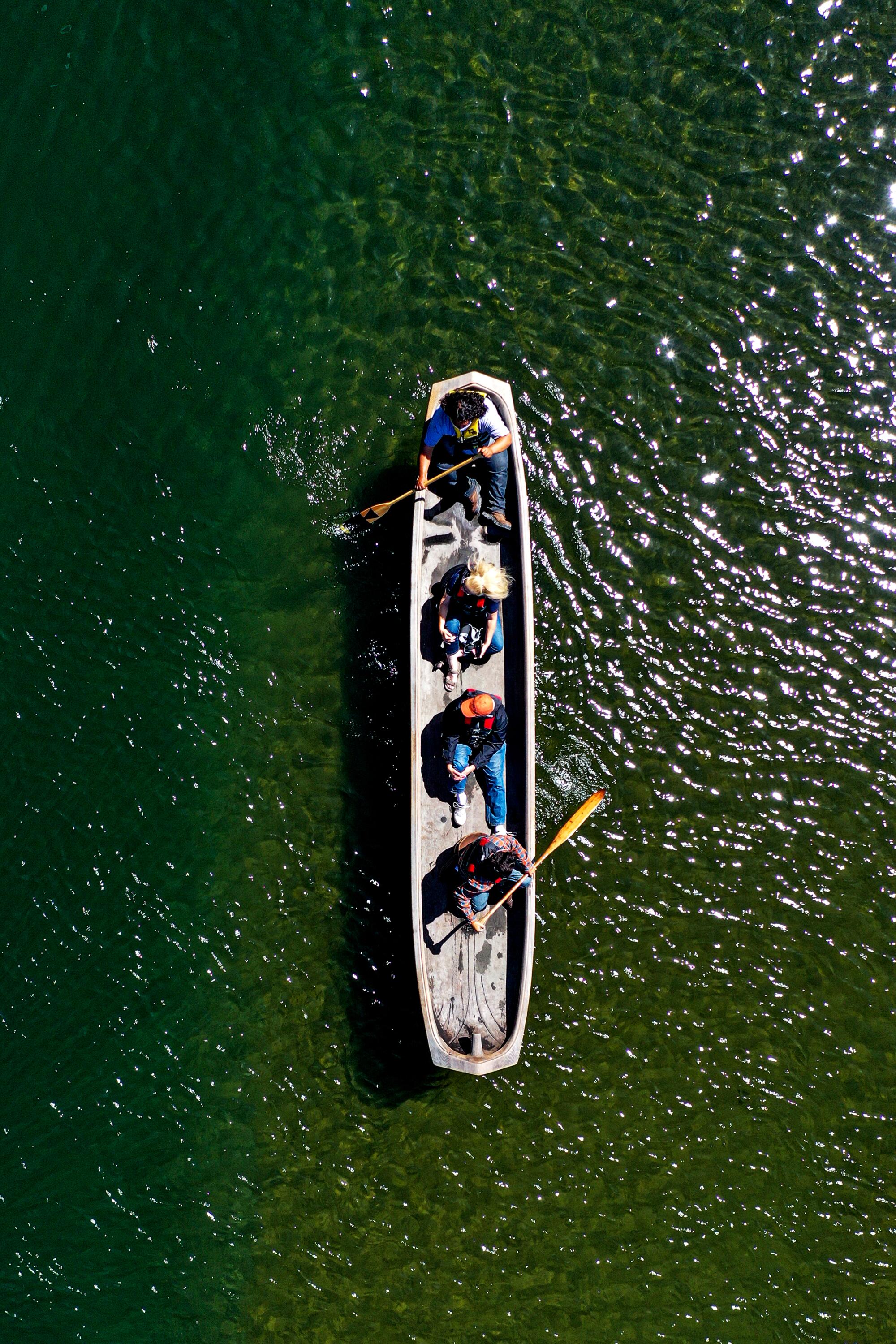
“If I can teach 100 kids,” Severns said, “maybe five of them will want to be canoe builders. … And out of the five, one is going to have a chance at a log.”
With a little luck, a carver can get two canoes from one log. But getting a big enough log with the correct grain, Severns said, is not easy. Nowadays, the tribe acquires them from the National Park Service, U.S. Forest Service and state parks.
When you calculate the cost of buying, transporting, storing and carving a redwood canoe, Sammy Gensaw told me, “These are $100,000 boats.”
Traditionally, the Yurok have built their canoes up to 20 feet long, 3.5 feet wide and 2 feet deep. Near the nose is a set of carved features known as the heart and lungs. Toward the back are two more raised shapes known as the kidneys, where paddlers rest their feet. The edge encircling the boat is known as the lifeline.
“We consider the redwood one of our protectors, and so we honor it by giving it those necessary body parts,” Norris said.
Back on the river
As we moved through the water, Sammy Gensaw talked about the mills and canneries that once lined the Klamath and the tribe’s battles against the upstream dams.
“I want to be able to live on this river. I want to be a fisherman. And I need a healthy river for that to happen,” he said.
The Yurok have the largest enrollment of any California tribe, with roughly 6,700 members, most of whom live off the reservation. Among those in the villages on the reservation, unemployment, poverty and substance abuse have run alarmingly high for years. It was a series of suicides four years ago that prompted new efforts to reinforce tribal culture and promote mental health.
The canoe project aligns with those goals, but it’s also counted as a tribal business venture, alongside a hotel and casino, the Riverside and Redwood RV parks, and Klamath Jet Boat Tours.
Norris and his team acknowledge that, for now, the river tour will likely be a supporting player, not the star, in most visitors’ itineraries.
But eventually, Norris said, he hopes to offer more canoe options, including overnight trips that highlight connections between the Yurok trail system and waterways.
I’ll be rooting for that. California has plenty of Native casinos, but not many chances for tribal members and outsiders to share nature and culture the way we did on the water.
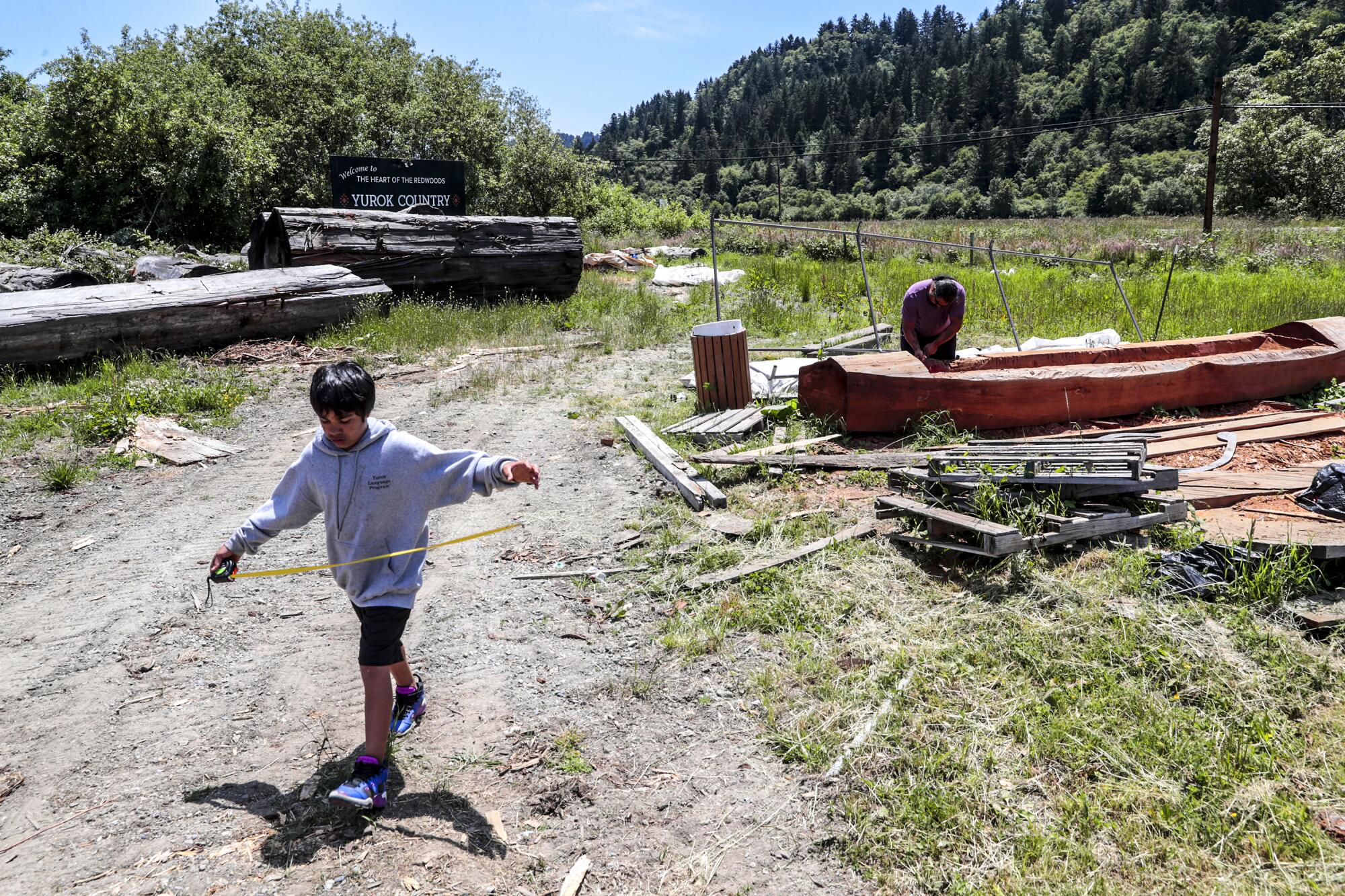
Paddling and drifting with the river, we covered about three miles.
Jon Luke recalled the time he fell asleep in his boat, “and when I woke up, a blue heron was staring me in the face. They’ve got crazy eyes.”
On our second day in redwood country, under a sky full of dramatic clouds, Gauthier and I made an impulse decision to go on the river again. The canoe team quickly agreed even as rain began to fall.
Just as we got out on the water, the heavens opened. Within minutes, we were soaked and mud-spattered, yet all three Yurok guides were grinning ear to ear. Men of the river, surrounded by water.
I’m going to remember that sight. But I’ll also remember what I heard in the last moments of our first-day float.
Sammy closed his eyes and improvised a paddling song, sending out slow syllables as the river slapped at the nose of the canoe. It might have been an 18th century moment, but as he explained, he was actually thinking ahead.
“If you guys come back in five years’ time, it’ll be the same boat,” Gensaw told us, “but a totally different experience.”

Adventures in redwood country
Here are several tips on how to best explore the tall trees and rugged coast of Humboldt and Del Norte counties. In three days, I sampled these options:
- Prairie Creek Trail leads hikers beneath and around the towering trees of Prairie Creek Redwoods State Park. The park’s Elk Prairie, Gold Bluffs and Fern Canyon areas are also popular. Redwoods National and State Parks includes miles of trails and coastline north and south of the Klamath River estuary, including the rocky coastal view from High Bluff Overlook.

- Klamath River Overlook, at the end of Requa Road, offers the region’s best and broadest view of the river as it empties into the sea. From that overlook, you can hike a steep trail (one mile down and back) that takes you toward the water.
- Klamath Beach, accessible from Highway 101 and Klamath Beach Road, is a natural and cultural site, and dramatically affected by the tides. If the tide is relatively low, you can park on the roadside and walk past traditional Yurok sweat houses and other structures to a sand spit where anglers cast between rock formations and seals play in “the chute” where the river and the sea meet.
If you go
The nearest airport to Klamath is California Redwood Coast-Humboldt County Airport, also known as the Arcata-Eureka Airport, in McKinleyville, about 50 miles south of Klamath. Its summer schedule includes flights on Sundays, Mondays, Wednesdays and Fridays from Burbank on Avelo Airlines, with one-way fares starting at $54-$79, plus fees for seat assignments, carry-ons and baggage.
Where to eat
Restaurants are rare in these parts, so at some point you’ll have breakfast or lunch at the Log Cabin Diner or dinner at the Redwood Casino’s Abalone Bar & Grill, both in Klamath, or a sandwich from Woodland Villa, about five miles north of Klamath on U.S. 101.
To book a redwood canoe tour, go to visityurokcountry.com. Two-hour tours ($125 per person) are offered Wednesdays-Sundays at 10 a.m., 12:30 p.m. and 3 p.m. Canoes hold three to four passengers and two guides.
More to Read
Sign up for The Wild
We’ll help you find the best places to hike, bike and run, as well as the perfect silent spots for meditation and yoga.
You may occasionally receive promotional content from the Los Angeles Times.


